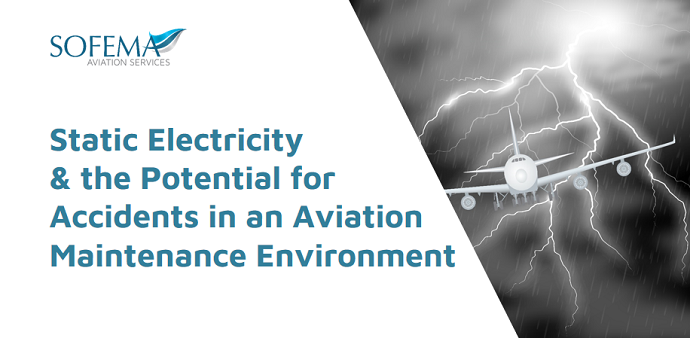Considerations presented by Sofema Aviation Services (SAS) www.sassofia.com regarding Static Electricity.
Example of an Adverse Outcome
A faulty forklift battery was to be returned to the manufacturer.
Per the manufacturer’s specifications, they put a plastic sheet over the battery and left it in the maintenance shop overnight.
Early the next morning, it exploded.
The blast shattered the window between the maintenance shop and an adjacent office and blew large shards of glass across the room; (some were found embedded in an office chair).
Fortunately, no one was in the office when the explosion occurred.
The Cause – (Suspected not proven) Static electricity in the plastic discharged and ignited hydrogen that had accumulated overnight underneath the covering.
The Danger of Explosions
Under certain circumstances, a discharge of static electricity can create the spark that starts a fire or triggers an explosion.
The explosion that destroyed the Hindenburg, for instance, is believed to have been caused by static electricity.
As a result, many industrial processes/operations need to be carefully scrutinized to minimize the possibility that static electricity will set off a devastating incident.
Precursors for static electricity to cause a fire or explosion.
- Sufficient charge needs to build up.
o Stacking plastic boxes.
o Pumping liquids or powders into containers.
o Conveying conductive materials through ducts or hoses.
o High-pressure CO2 discharged as a liquid can also build upcharge.
o Charge can build up in certain materials such as plastics and moist wood that are otherwise non-conductive.
- Build-up can also be influenced by environmental conditions.
o Drier air will better insulate the adjacent materials and therefore promote Static build-up.
NOTE: During Winter Months Electrostatic Incidents are more likely during winter months when the air is colder and drier.
- Fuel and oxygen need to be present.
o The quantities of these, plus the flammability/explosivity of the fuel source, affect the size and intensity of the resulting fire or explosion.
- Discharge must take place Discharge occurs when differently charged materials interact in certain ways.
- Finally, if the electrostatic discharge has sufficient ignition energy.
o The level needed will depend on the flashpoint of the fuel source(s).
o The conditions will have been met, and fire or explosion will ensue.
Practical Measures for Limiting Exposure
- Limiting the buildup of charge.
- Allowing charges to recombine harmlessly.
- Controlling ignition hazards.
Grounding and bonding are essential components of the protection concept
In particular, ducts, pipes and hoses should be bonded and grounded along the entire path.
What are the effects of Grounding?
- Grounding equalizes the potential imbalance between negative and positive charges in objects and earth.
- It should be achieved through a dedicated system that is not connected with the electrical earth. (Best Practice to avoid back charge)
In Aircraft systems it is normal practice for Bonding to be used to connect two or more objects to equalize the electrical potential.
Bonding wires are also used when the grounding path is interrupted.
Consider the effect of painted parts, non-conductive gaskets, or similar obstructions.
Next Steps
Sofema Aviation Services (SAS) www.sassofia.com & SofemaOnline (SOL) www.sofemaonline.com offer classroom, webinar & online training related to Electrostatic Sensitive Discharge (ESDS) Please visit the websites or email team@sassofia.com for further details.
Tags:
aviation, Aviation Maintenance, Danger of Explosions, Electrostatic Sensitive Discharge, Electrostatic Sensitive Discharge training, ESDS, Potential for Accidents, SAS blogs, Static Electricity




